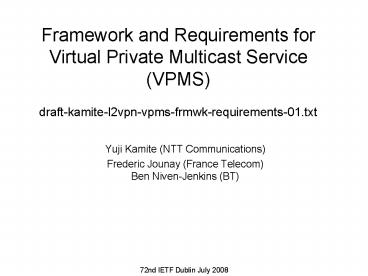Framework and Requirements for Virtual Private Multicast Service VPMS draftkamitel2vpnvpmsfrmwkrequi
1 / 10
Title:
Framework and Requirements for Virtual Private Multicast Service VPMS draftkamitel2vpnvpmsfrmwkrequi
Description:
IP-based TV broadcasting. Audio/video device with Ether interface (MPEG-TS, HD-SDI) MPEG-TS/IP/Ethernet in DVB-H with static multicast. ATM-based Use Case (Section ... – PowerPoint PPT presentation
Number of Views:33
Avg rating:3.0/5.0
Title: Framework and Requirements for Virtual Private Multicast Service VPMS draftkamitel2vpnvpmsfrmwkrequi
1
Framework and Requirements for Virtual Private
Multicast Service (VPMS)draft-kamite-l2vpn-vpms-
frmwk-requirements-01.txt
- Yuji Kamite (NTT Communications)
- Frederic Jounay (France Telecom)Ben
Niven-Jenkins (BT)
2
Introduction
- What is VPMS?
- VPMS is defined as a Layer 2 service that
provides point-to-multipoint connectivity for a
variety of Layer 2 link layers across an IP or
MPLS-enabled PSN. - Difference from other L2VPNs
- VPWS supports point-to-point only no replication
- VPLS supports replication but requires full-mesh
and MAC forwarding (VSI) - WG Re-chartering
- L2VPN WG Re-chartering proposal to take VPMS
- PWE3 WG Re-chartered to take P2MP-PW (potential
solution) - This drafts objective
- Introduce service framework and become a base
reference - Specify functional requirements to guide a proper
solution
3
Use Cases
- Ethernet Use Case (Section 4.1)
- IP-based TV broadcasting
- Audio/video device with Ether interface (MPEG-TS,
HD-SDI) - MPEG-TS/IP/Ethernet in DVB-H with static
multicast - ATM-based Use Case (Section 4.2)
- IP multicast wholesale
- p2mp PVPs/PVCs
- TDM-base Use Case (Section 4.3)
- Mobile backhauling -- deliver the clock
(CESoPSN, SAToP, TDMoIP)
4
Reference Model
VPMS A
VPMS A
PE1
PE2
CE1
CE2
Sender
Receiver
AC2
AC1
VPMS B
VPMS B
CE4
CE3
VPMS B
Receiver
AC3
Sender
AC4
VPMS A
Routed Backbone
PE3
AC6
AC5
CE Customer Edge PE Provider Edge AC
Attachment Circuit
CE5
CE6
VPMS A
VPMS B
Receiver
Receiver
- A VPMS instance corresponds to a unique
unidirectional P2MP topology - AC is configured as "sender" or "receiver" not
both.
5
Requirements Summary
- Customer Requirements (Section.2)
- Service Topology
- Transparency
- QoS
- Protection and Restoration etc.
- Provider Requirements (Section.3 )
- Scalability
- PW signaling / PSN tunneling (Details will be
covered by P2MP-PW Reqts work) - Auto-Discovery
- Activation and Deactivation
- Inter-AS etc.
6
Multiple Source Support
AC2
CE1
CE2
AC1
VPMS A
VPMS A
Sender
Sender
VPMSPE1
VPMSPE2
VPMSPE3
VPMSPE4
AC3
AC4
VPMS A
VPMS A
CE5
CE4
Receiver
Receiver
- MUST support multiple sender topologies in one
VPMS instance - Each P2MP topology MUST only have a single
sender, however multiple P2MP topologies can be
grouped together into a single VPMS instance. - (For protection and restoration at sender-side)
7
Reverse Traffic Support
CE1
Sender
VPMS A
Tx
Rx
VPMS B
Receiver
AC1
AC2
PE1
VPMS B
AC4
AC3
VPMS A
VPMS A
CE2
CE3
Receiver
Receiver
Rx
Rx
VPMS A
PE2
PE3
PE4
Unique instance per direction
AC6
AC5
Tx
Rx
Receiver
VPMS A
CE5
Sender
VPMS B
- Every AC is considered unidirectional
- Direction is an additional element to identify a
unique AC - L2 header/circuit (e.g., VLAN id, Physical port
)plus traffic direction (Tx or Rx )
8
Auto-discovery
- Discovering VPMS Related Information
- SHOULD support auto-discovery methods to minimize
the amount of configuration the SP must perform - Information Example
- PE router ID / IP address as location
information - Information to identify ACs and their VPMS
instance - CE role in each VPMS (Sender and/or Receiver)
9
Activation / Deactivation
VPMS A
CE1
Sender
Single-sided activation on each AC at source PE
AC1
PE1
AC3
AC2
VPMS A
CE2
CE3
Receiver(activated)
NO VPMS provisioned
PE2
PE3
PE4
AC4
AC5
deactivated
VPMS A
VPMS A
CE5
CE4
Receiver(activated)
Receiver(deactivated and not receiving data)
- SHOULD provide a way to activate/deactivate the
administrative status of each CE/AC. - SHOULD allow single-sided activation operation at
a sender PE (for centralized control)
10
Next Step
- Remaining major work
- OAM
- Security
- This draft is being well coordinated with P2MP
Reqts work (draft-jounay-pwe3-p2mp-pw-requirements
) that is proposed in PWE3 - Propose to adopt this as a WG document- to have
consensus on this basic framework































